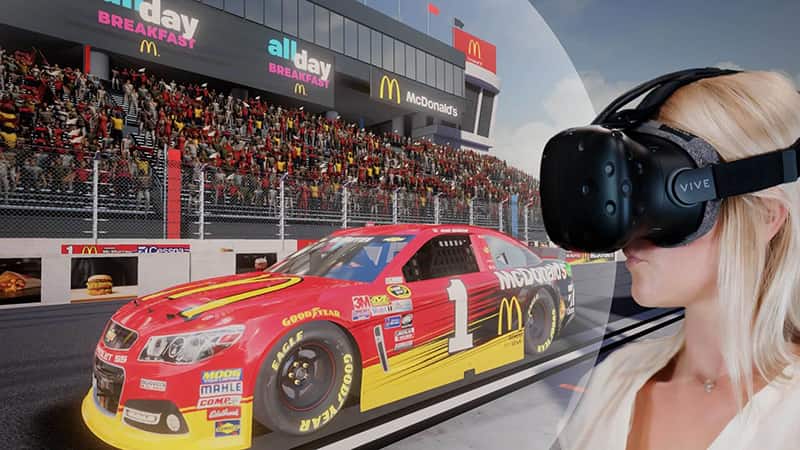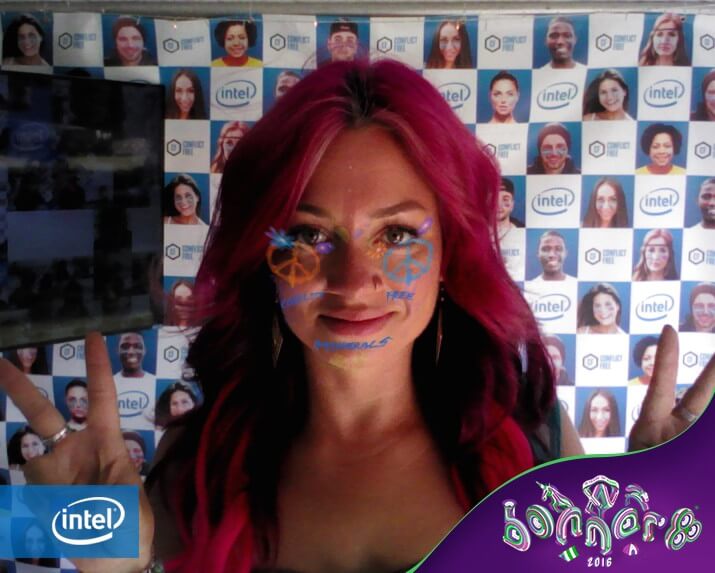Americans see up to10,000 adsevery day.
Because consumers are exposed to such a high volume of promotions, brands need to find new and exciting ways to communicate with consumers. Often, they choose to hire a digital marketing firm to promote products and services, and improve brand recognition.
Enter: Virtual reality and augmented reality.
Table of Contents
- Virtual Reality vs. Augmented Reality
- VR and AR Improve Marketing Campaigns
- The Platforms & Channels That Support Virtual Reality & Augmented Reality
- 10 VR/AR Best Practices That Brands Should Follow
- 4 Effective VR Marketing Campaigns
- 4 Successful AR Marketing Campaigns
- How Much Do Virtual Reality & Augmented Reality Initiatives Cost?
- Why VR/AR Campaigns Can Foster Long-Term Business Growth
Virtual Reality vs. Augmented Reality
Virtual reality (VR) and augmented reality (AR) both change viewers concept of the world, but through different tactics.
VR transports the user out of their current reality and into a new, digital space. This is achieved best through googles and headsets that block out the real world and allow the user to focus on the virtual reality in which they are now interacting.
Conversely, augmented reality simply shifts or changes a user’s perspective of their world, often my implanting virtual aspects that are visible through goggles, headsets or a mobile device screen and corresponding application.
Both VR and AR can use 360-degree video to capture scenery, or computer-generated imagery (CGI) to create a digital environment.
The main difference between 360-degree video and virtual reality is that 360-degree videos still require manual movement from users and maintain limits in visuals, interactions and setting.
360-degree videos record every direction at the same time. This simulates virtual reality because it can immerse viewers into the multimedia.
But true virtual reality is achieved through CGI. It allows the experience to appear limitless and thus engages users in a way that 360-degree video simply cannot.
Nonetheless, most people use 360-degree video and virtual reality interchangeably, especially for full-service marketing purposes. After all, they have exceedingly similar qualities and achieve the same objective overall – and quite well, too.
VR and AR Improve Marketing Campaigns
72% of marketers plan to use augmented reality within the next year.
“With a multimedia marketing campaign, I could show you a video of a man atop Everest with copy that read that "X" product is ‘...everywhere you could ever be,’” says Mark Matthews, an experience strategist at NEXT/NOW – a leading digital experiential marketing agency based in Chicago. “Or, I could just place you directly on top of Everest and prove it to you with the help of immersive video.”
Matthews explains that traditional video marketing explains brands from the outside looking in, but VR/AR technology enables consumers to become a part of the story. This is ultimately more effective in demonstrating brand value clearly and accurately.
“Video is often a fixed point of view, but VR/AR allows the user to explore and "discover" more – it is actively engaging,” says Matthews. “Users can pursue as much or as little information as suits them.”
Top AR/VR Companies
How VR Is Used In Marketing
Virtual reality has many business-building benefits. These include:
Gamification
Consumers can immerse themselves in games through VR, headsets and hand controllers.
Branding & Content
Virtual reality transforms traditional content marketing into immersive storytelling. This allows consumers to better understand a brand’s core values, mission, offering and important information that fosters conversions.
Tourism
VR technology allows businesses to give unlimited tours of facilities, towns, cities, workspaces and more which showcasing the benefits.
Live Streaming
Businesses can use VR to live stream events, conferences and more directly to users without needing a middleman.
Experiential Design
Experiential marketing (like popups, booths and temporary museums) is increasing in popularity, and virtual reality technology allows brands to take that experience one step further by immersive visitors fully into their brand.
Digital Marketing Campaigns
Utilizing VR in a bevy of video-centric digital marketing campaigns is an accessible wait to integrate this tech into your marketing strategy. These include renderings, 360-degree videos and more. Many digital creative agencies now leverage cutting-edge technologies like VR to enhance storytelling and user engagement.
How AR Is Used In Marketing
Interestingly enough, augmented reality has been in practice for upwards of 20 years. In fact, a real-world example is the blue line of scrimmage seen in broadcasted football games, because that line does not exist in the real world.
With that being said, there are several ways in which AR is utilized in marketing, such as:
Gamification
Like virtual reality, augmented reality fosters great gamification experiences. However, these games are integrated with real-world scenarios and environments, making them truly engaging.
3-D Renderings
Many professional mobile apps – especially design, décor and furniture companies – utilize augmented reality. Through AR, users can place products in their personal space to see how they would look, allowing them to quickly and easily see the real-world value of a product.
Social Media
Social media filters, notably on Instagram and Snapchat, also use augmented reality. Brands can create filters, stickers, geotags, GIFs and more to encourage customers to interact with their brand online.
Navigation
Augmented reality helps users navigate office spaces, cities, airports and other complex entities, allowing them to find their way quickly.
Should Your Brand Conduct VR Or AR Marketing Campaigns?
Unfortunately, there’s no simple answer for that – it all depends on your budget, goals, brand identity and vision.
“They are both good for different things,” says Matthews. “AR is a strong choice when you want to interact with the actual world, products, objects around you. But VR excels at full immersion. My advice would be to reach out to a professional and clarify your end goals. They can give you examples of what a campaign would look like in each technology and help hone in on the best solution.”
The Platforms & Channels That Support Virtual Reality & Augmented Reality
Many people immediately associate virtual reality and augmented reality with standalone devices and bulky headsets. The most common headsets include:
- HTC Vive
- Oculus Rift
- Samsung Gear VR
- Google Cardboard
- Microsoft MR
However, VR/AR initiatives don’t always need additional technology in order to be successful promotional tools.
“AR can be using the camera on a phone or tablet, while large-scale AR can be created using large video walls and digital cameras,” says Matthews. “VR can be used on common smartphones with that addition of a portable viewer, like the Google Cardboard, though they will lack the full immersion that the more expensive headsets provide.”
Ultimately, experiential marketing such as virtual reality and augmented reality can still captivate consumers and encourage conversions on a traditional desktop or mobile device.
In particular, NEXT/NOW recommends posting your VR/AR campaigns on:
- YouTube
- Vimeo
These three platforms offer 360-degree video options, while mimics the immersion that virtual reality headsets provide best.
Augmented reality features are also particularly effective on mobile apps. Those platforms empower users to view the “real” world through their mobile phones, then place virtual components into their view to add gamification, a comprehensive product view, improve brand awareness and beyond.
Facebook founder Mark Zuckerburg recently corroborated this in an interview with TechCrunch, when he said he expects mobile phones to become the primary host of augmented reality multimedia and interactions.
Some great examples of augmented reality mobile apps include:
- IKEA Place
- Pokémon Go!
10 VR/AR Best Practices That Brands Should Follow
Implementing virtual reality or augmented reality into your marketing strategy may seem daunting, but there are some general tips to follow that will make the transition easier for your brand and streamlined for your customers.
Top digital experiential marketing company NEXT/NOW rounded up the top 10 best practices for AR/VR, which include:
1. Create a unique experience
Virtual reality is the most effective when you transport users to a world or adventure that they wouldn’t normally experience. This ensures your high-tech marketing campaign is memorable.
2. Be personal
AR/VR campaigns have the distinct ability to engage users directly into a storyline or experience. Use that to your advantage and personalize as much as you can.
3. Think big
Think about your brand’s mission and long-term goals, then craft a virtual experience that reflects that (such as sending users to the future). This will subtly reinforce your brand’s message without compromising the storyline.
4. Take users on an active journey
If you’re going to create an AR/VR experience, ensure it maintains engaging components at every moment. While some users may want a more relaxed experience, others may get bored without new digital activities or interactions. Try to cater to both, but when in doubt, keep the user’s virtual journey moving along at a brisk pace.
Top Digital Agencies
5. Incorporate humanity
Because AR/VR is so immersive, it is the perfect opportunity to capitalize on emotions, communicate your business’s viewpoint, or show the heart and soul of your brand to customers.
6. Show users, don’t tell
7. Remember the 5 senses
It is possible in high-tech experiences to engage the others senses, such as touch and smell. If you are able to do so, it will improve your experiential marketing even more.
8. Stay user-friendly
Immersive experiences run the risk of motion sickness and other real-world consequences. Always design your virtual reality and augmented reality environments with the users in mind first and foremost.
9. Engage others in the room
Especially if you’re creating an AR/VR experience involving goggles or a headset, you still have a whole room of people you can market to who aren’t using your tech right that moment. Incorporate 2-D renderings of what the person in the environment is experiencing to engage the others present.
10. Strike while the iron’s hot
The digital space is always evolving and we don’t know when the next big trends will hit. However, we do know that augmented reality and virtual reality are popular and effective now. If you’re going to invest in AR/VR technology, now’s the time.
“In reality, the number one tip is to reach out early and often to a professional that can guide you from the beginning,” says Matthews. “There are best practices that should be addressed as early as the conception phase to ensure a seamless, comfortable, and on-point experience for the user. In some cases, we have recommended to our clients another technology because AR/VR did not quite suit their goals. We have also walked the path enough times to avoid all the common mistakes and pitfalls that newcomers may encounter.”
4 Effective VR Marketing Campaigns

McDonald’s
NEXT/NOW transported NASCAR fans to the racetrack during the 2016 Sprint Cup Series.
Users could put on an HTC Vive headset to visit McDonald’s-sponsored driver Jamie McMurray’s pitstop. In the experience, they helped him change tired and rejoin the race.

Mike’s Hard
This nostalgic VR brand experience immersed users into a colorful game filled with puppies, dolphins and a battle against mischievous fruit.
Under Armour
Under Armour’s VR experience, created by NEXT/NOW, allowed users to tour the new Brand House before it opened. This ramped up excitement in consumers throughout the construction process.
Progressive Insurance
As the sponsor of the National Marine Manufacturer’s Association 2018 Boat Shows, Progressive partnered with NEXT/NOW to create a virtual boat race on a CGI lake. So far, over 20,000 consumers have used Oculus Rift goggles to compete in The Progressive LAKE DASH VR Trade Show Experience.
4 Successful AR Marketing Campaigns
Cummins
Cummins partnered with NEXT/NOW to create an AR tour at the North American Commercial Vehicle Show. The popup used tables like interactive windows that empowered consumers to interact with their new electric semi-truck.
Trek
Cycling company Trek built an in-store augmented reality kiosk that used recording and motion tracking to analyze a rider’s movements and offer technical feedback and product suggestions.
Mazda
NEXT/NOW created an AR pit stop experience for Mazda. Cameras project users into a real NASCAR pit stop scene where they can interact with the crew, drivers, prototype cars and more.

Intel
Tech company hit the music festival circuit with the help of NEXT/NOW. With Intel RealSense technology, the experiential booth added virtual face paint to visitors at Bonnaroo in 2016.
How Much Do Virtual Reality & Augmented Reality Initiatives Cost?
Virtual reality and augmented reality marketing campaigns are unique and capture consumers – but producing those videos will cost you.
“The pricing is diverse and more or less bound by how much animation and programming there is involved,” says Matthews. “Pricing can vary anywhere from $75,000 - 250,000 (or more) depending on how complicated and in-depth the ask is.”
Although it’s a large investment, VR/AR technology provides a strong return on investment. Studies show that 90 percent of enterprise companies with over $100 million in revenue now utilize augmented reality or virtual reality.
Why VR/AR Campaigns Can Foster Long-Term Business Growth
Ultimately, AR/VR technology can market brands effectively, build brand awareness, and capture consumers in a way that traditional marketing simply can’t. Augmented reality and virtual reality can instill awe, communicate your brand story with customers, and inform users without relying on heavy text or boring stock images.
“The great thing about these technologies is that the sky is the limit in terms of what you can imagine,” says Matthews.
And, as it turns out, with virtual reality and augmented reality, the sky’s the limit for business growth, too. Leveraging partnerships with specialized AR and VR tech companies can offer businesses cutting-edge tools for customer engagement and data-driven insights that steer long-term strategy.
Privately owned NEXT/NOW has transported people to the future, to virtual racetrack pits, and to peaceful bioluminescent forests. With a toolbox that’s brimming with virtual and augmented reality, gesture, LED, holograms, facial tracking, multi-touch screens and more, NEXT/NOW connects people with brands in deeply immersive environments that dial up the “wow” factor.
Contact NEXT/NOW here and create your own VR/AR marketing campaign.









